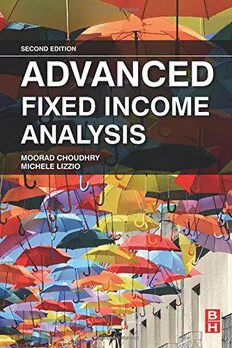
Advanced Fixed Income Analysis, Second Edition PDF
Preview Advanced Fixed Income Analysis, Second Edition
Advanced Fixed Income Analysis Advanced Fixed Income Analysis 2nd Edition Moorad Choudhry Michele Lizzio AMSTERDAM (cid:129) BOSTON (cid:129) HEIDELBERG (cid:129) LONDON NEW YORK (cid:129) OXFORD (cid:129) PARIS (cid:129) SAN DIEGO SAN FRANCISCO (cid:129) SINGAPORE (cid:129) SYDNEY (cid:129) TOKYO Butterworth-Heinemann is an imprint of Elsevier ButterworthHeinemannisanimprintofElsevier 525BStreet,Suite1800,SanDiego,CA92101,USA TheBoulevard,LangfordLane,Kidlington,OxfordOX51GB,UK 225WymanStreet,Waltham,MA02451,USA ©2015ElsevierLtd.Allrightsreserved. Firstedition©2003. Nopartofthispublicationmaybereproducedortransmittedinanyformorbyanymeans,electronic ormechanical,includingphotocopying,recording,oranyinformationstorageandretrievalsystem, withoutpermissioninwritingfromthepublisher.Detailsonhowtoseekpermission,further informationaboutthePublisher’spermissionspoliciesandourarrangementswithorganizations suchastheCopyrightClearanceCenterandtheCopyrightLicensingAgency,canbefoundatour website:www.elsevier.com/permissions. Thisbookandtheindividualcontributionscontainedinitareprotectedundercopyrightbythe Publisher(otherthanasmaybenotedherein). Notices Knowledgeandbestpracticeinthisfieldareconstantlychanging.Asnewresearchandexperience broadenourunderstanding,changesinresearchmethods,professionalpractices,ormedical treatmentmaybecomenecessary. Practitionersandresearchersmustalwaysrelyontheirownexperienceandknowledgeinevaluating andusinganyinformation,methods,compounds,orexperimentsdescribedherein.Inusingsuch informationormethodstheyshouldbemindfuloftheirownsafetyandthesafetyofothers,including partiesforwhomtheyhaveaprofessionalresponsibility. Tothefullestextentofthelaw,neitherthePublishernortheauthors,contributors,oreditors,assume anyliabilityforanyinjuryand/ordamagetopersonsorpropertyasamatterofproductsliability, negligenceorotherwise,orfromanyuseoroperationofanymethods,products,instructions,or ideascontainedinthematerialherein. BritishLibraryCataloguinginPublicationData AcataloguerecordforthisbookisavailablefromtheBritishLibrary LibraryofCongressCataloging-in-PublicationData AcatalogrecordforthisbookisavailablefromtheLibraryofCongress ISBN:978-0-08-099938-8 ForinformationonallButterworthHeinemannpublications visitourwebsiteathttp://store.elsevier.com/ PrintedandboundintheUnitedStates Theviews,thoughtsandopinionsexpressedinthisbookrepresentthoseoftheauthorsintheir individualprivatecapacities,andshouldnotinanywaybeattributedtoHabibBankZurichplc,the HabibBankAGZurichGroup,orDeloitteFinancialAdvisoryS.r.l,ortoMooradChoudhryasa representative,officer,oremployeeofHabibBankZurichplcortheHabibBankAGZurichGroup, orMicheleLizzioasanemployeeofDeloitteFinancialAdvisoryS.r.l. Publisher:NikkiLevy AcquisitionEditor:ScottBentley EditorialProjectManager:SusanIkeda ProductionProjectManager:JasonMitchell Designer:MarkRogers Dedication Moorad Choudhry For my grandfather, Mr Abdul Hakim (c. 1898–1983), Advocate Citizen of Noakhali, Bangladesh and Michele Lizzio For my mum and dad About the Authors Moorad Choudhry is CEO of Habib Bank Zurich plc in London, and Visiting Professor at the Department of Mathematical Sciences, BrunelUniversity.HeisFounderofTheCer- tificate of Bank Treasury Risk Management (BTRM). Moorad has over 25 years experience in bankingintheCityofLondonandwasprevi- souly IPO Treasurer at the Royal Bank of Scotland,HeadofTreasuryatRBSCorporate Banking, Head of Treasury at Europe Arab Bank, Head of Treasury at KBC Financial Products and vice-president in structured finance servicesat JPMorgan Chase Bank. Moorad is a Fellow of the Chartered Institute for Securities & Investment and a Fellow of IFS-University College. He is Editor of Review of Financial Markets, and the author of The Principles of Banking (John Wiley & Sons 2012). Michele Lizzio is Senior Analyst at Deloitte Financial Advisory, Valuation Services in Milan. He has experience in equity valuation andisinvolvedinthedevelopmentandimple- mentationoffixedincomeandderivatebased modelsinDeloitte. HegraduatedcumlaudeinMScCorporate FinancefromUniversityofBrescia.Hebegan his career collaborating with Alberto Falini, Professor of Corporate Finance at University of Brescia. xiii Preface Everythinginlifeisrelative.Oneperson’ssimpleisanotherperson’sdifficult. Comparisonsareoftenproblematictoundertake,becauseofthedifficultieswith ensuringthatoneismeasuringlikeagainstlike.SowebegintheSecondEdition of Advanced Fixed Income Analysis with the caveat that while it may be “advanced” to some it may well not be to others. But nevertheless it is worth updatingthebooksimplytoreflectchangesinthinkingandapproachthathave occurred since the First Edition was published. Whatisworthythenofafurtherinvestmentofcashtopurchasethissecond edition?Hopefullythenewchaptersonassetswapspreadrelativevalue,con- vertiblebonds,callable/putablebondsandfloating-ratenoteswillbesufficient justification; additionally wehave updated thepreviouschaptersoninflation- linkedbondsandriskycorporatebondsvaluation.WehavealsoincludedExcel spreadsheetsthatenablethereadertoapplytheanalysisdescribedinthechap- ters right away tobonds thathe orshe selects. We have deleted the chapters on cubic spline (a technique now very well knownandwithplentyofmaterialaboutitoutthereontheinternet)andBrady bonds.Wehavealsoremovedtheearlieredition’schaptersonrisk-freesover- eignbondstrading,onthegroundsthatthelogicofanalysisemployedforsuch investmentshasnotchangedsince2003,andalsomoreindirectlybecausethere are sofew genuinely risk-free sovereign issuers left inthe world! Iamgratefultomynewco-authorforthisSecondEdition,MicheleLizzio, for his tireless and energetic input. Asalwaysreadersarewelcometosendfeedbackdirect,pleaseemailmeat [email protected] We hope youenjoy the book. xv xvi Preface MooradChoudhry Surrey, England February2015 MicheleLizzio Milan, Italy February2015 Preface to the First Edition (published 2004) THE DYNAMICS OF THE YIELD CURVE Inchapter2ofthecompanionvolumetothisbookintheboxed-setlibrary,Cor- porateBondsandStructuredFinancialProducts,weintroducedtheconceptof the yield curve, and reviewed some preliminary issues concerning both the shapeofthecurveandtowhatextentthecurvecouldbeusedtoinfertheshape andleveloftheyieldcurveinthefuture.Wedonotknowwhatinterestrateswill beinthefuture,butgivenasetofzero-coupon(spot)ratestodaywecanesti- matethefuturelevelofforwardratesusingayieldcurvemodel.Inmanycases howeverwedonothaveazero-couponcurvetobeginwith,soitthenbecomes necessarytoderivethespotyieldcurvefromtheyieldsofcouponbonds,which onecanobservereadilyinthemarket.Ifamarketonlytradesshort-dateddebt instruments, then it willbe possibleto constructashort-dated spot curve. Itisimportantforazero-couponyieldcurvetobeconstructedasaccurately aspossible.Thisbecausethecurveisusedinthevaluationofawiderangeof instruments, not only conventional cash market coupon bonds, which we can valueusingtheappropriatespotrateforeachcashflow,butotherinterest-rate productssuch asswaps. Ifusingaspotratecurveforvaluationpurposes,banksusewhatareknown asarbitrage-freeyieldcurvemodels,wherethederivedcurvehasbeenmatched tothecurrentspotyieldcurve.Theconceptofarbitrage-free,alsoknownasno- arbitragepricingor“thelawofoneprice”isthatifoneisvaluingthesameprod- uct or cash flow in two different ways, the same result will be obtained from either method. So as we demonstrated in chapter 6, if one was valuing a two-yearbondthatwasput-ablebytheholderatparinoneyear’stime,itcould beanalysedasaone-yearbondthatentitledtheholdertoreinvestitforanother year. The rule of no-arbitrage pricing states that an identical price will be obtained whichever way one chooses to analyse the bond. When matching derivedyieldcurvestherefore,correctlymatchedcurveswillgeneratethesame pricewhenvaluingabond,whetheraderivedspotcurveisusedorthecurrent term structure ofspot rates. Fromourunderstandingofderivatives,weknowthatoptionpricingmodels suchasBlack-Scholesassumethatassetpricereturnsfollowalognormaldis- tribution.Thedynamicsofinterestratesandthetermstructureisthesubjectof xvii xviii PrefacetotheFirstEdition somedebate,andthemaindifferencesbetweenthemaininterest-ratemodelsis inthe way that they choose to capture the change inrates over a time period. However although volatility ofthe yield curve isindeed the main areaof dif- ference, certain models are easier to implement than others, and this is a key factorabankconsiderswhendecidingwhichmodeltouse.Theprocessofcal- ibratingthe model,thatis, settingit uptoestimatethe spot andforwardterm structure using current interest rates that are input to the model, is almost as important as deriving the model itself. So the availability of data for a range of products, including cash money markets, cash bonds, futures and swaps, isvital tothe successfulimplementation ofthe model. Asonemightexpecttheyieldsonbondsarecorrelated,inmostcasesvery closely positively correlated. This enables us to analyse interest-rate risk in a portfolio for example, but also to model the term structure in a systematic way.Muchofthetraditionalapproachtobondportfoliomanagementassumed aparallelshiftintheyieldcurve,sothatifthe5-yearbondyieldmovedupwards by10basispoints,thenthe30-yearbondyieldwouldalsomoveupby10basis points.Thisunderpinstraditionaldurationandmodifieddurationanalysis,and theconceptofimmunisation.Toanalysebondsinthisway,weassumetherefore thatbondyieldvolatilitiesareidenticalandcorrelationsareperfectlypositive. Althoughbothtypesofanalysisarestillcommon,itisclearthatbondyieldsdo notmoveinthisfashion,andsowemustenhanceourapproachinordertoper- formmoreaccurateanalysis. FACTORS INFLUENCING THE YIELD CURVE Fromthediscussioninchapterweareawarethattherearerangeoffactorsthat impact onthe shape andlevel oftheyieldcurve.Acombinationofeconomic andnon-economicfactorsareinvolved.Akeyfactor isinvestorexpectations, with respect to the level of inflation, and the level of real interest rates in the future. In the real world the market does not assume that either of these two factorsisconstant,howevergiventhatthereisahighleveluncertaintyoverany- thing longer than the short-term, generally there is an assumption about both inflation and interest rates to move towards some form of equilibrium in the long-term. Itispossibletoinfermarketexpectationsaboutthelevelofrealinterestrates going forward by observing yields in government index-linked bonds, which trade in a number of countries including the US and UK. The market’s view onthefuturelevelofinterestratesmayalsobeinferredfromtheshapeandlevel ofthecurrentyieldcurve.Againfrom chapter6,wesawthattheslopeofthe yieldcurvealsohasaninformationcontent.Thereismorethanonewaytointer- pretany given slopehowever, and thisdebateisstill open. Thefactthatthereareanumberoffactorsthatinfluencechangesininterest rates and the shape of the yield curve means that it is not straightforward to
